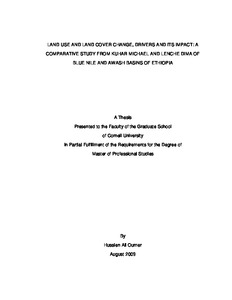Resource information
Land use and land cover change is driven by human actions and also drives changes that limit availability of products and services for human and livestock, and it can undermine environmental health as well. Therefore, this study was aimed at understanding land use and land cover change in Lenche Dima and Kuhar Michael of Amhara region, Ethiopia. Time-series satellite images that included Landsat MSS, TM, ETM+ and ASTER, which covered the time frame between 1972/3 to 2005, were used. Socio-economic Survey and review of documents was carried out to understand historical trends, collect ground truth and other secondary information required. Analysis of data and other data was accomplished through integrated use of ERDAS imagine (version 9.1), ENVI (version 4.3) and ArcGIS (version 9.2) software packages along with Microsoft office analytical tools. Remote sensing analysis revealed landscape level change of cultivated land to have a net increase in Kuhar Michael, while a decline is found for Lenche Dima. However, socio-economic surveys showed that household level cultivated land has decreased from 1.2ha to 1ha and from 2.2ha to 1.8ha in Kuhar Michael and Lenche Dima respectively, over the last 30years. Major contributing factors included population increase, occurrence of drought, land redistribution, and land degradation. Similarly, average land holding per household has decreased from 1.6ha to 1.5ha and from 2.9ha to 2.2ha in Kuhar Michael and Lenche Dima, respectively. This has jeopardized the capacity of individuals to provide land for their siblings further leading to landlessness, which is becoming a common phenomenon among rural youths. In Kuhar Michael, dense shrub/bush land decreased at an annual rate of -0.1%, while open shrub/bush land increased at a rate of 0.3%. As opposed to this, dense shrub/bush land increased at a rate of 0.2% and open shrub/bush land declined at annual rate of -0.2% in Lenche Dima. Grassland showed a net decrease at a rate of -0.3% in Kuhar Michael due to conversion into cultivated lands, while an increase with annual rate of 0.1% is found in Lenche Dima as a result of implementation of watershed management practices. Along with the observed decrease in vegetation cover, Limited availability and extinction of some tree/shrub species is also reported and research is required to quantify changes and understand the real impacts brought about.



